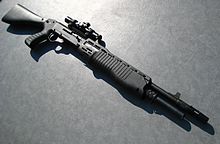
A firearm is any type of gun that uses an explosive charge and is designed to be readily carried and used by an individual. The term is legally defined further in different countries.

A shotgun is a long-barreled firearm designed to shoot a straight-walled cartridge known as a shotshell, which discharges numerous small spherical projectiles called shot, or a single solid projectile called a slug. Shotguns are most commonly used as smoothbore firearms, meaning that their gun barrels have no rifling on the inner wall, but rifled barrels for shooting sabot slugs are also available.

In firearms terminology, an action is the functional mechanism of a breech-loading firearm that handles the ammunition cartridges, or the method by which that mechanism works. Actions are technically not present on muzzleloaders, as all those are single-shot firearms with a closed off breech with the powder and projectile manually loaded from the muzzle. Instead, the muzzleloader ignition mechanism is referred to as the lock.

The Colt AR-15 is a lightweight, magazine-fed, gas-operated semi-automatic rifle. It is a semi-automatic version of the M16 rifle sold for the civilian and law enforcement markets in the United States. The AR in AR-15 stands for ArmaLite rifle, after the company that developed it in the 1950s. Colt's Manufacturing Company currently owns the AR-15 trademark, which is used exclusively for its line of semi-automatic AR-15 rifles.
The Benelli M4 is a semi-automatic shotgun produced by Italian firearm manufacturer Benelli Armi SpA, and the fourth and last model of the Benelli Super 90 line of semi-automatic shotguns. The M4 uses a proprietary action design called the "auto-regulating gas-operated" (ARGO) system, which was created specifically for the weapon. Designed in 1998, the M4 was adopted by the armed forces of Italy, the United States, and United Kingdom, among others, and has been used in a variety of conflicts.

The Mossberg 500 (M500) is a series of pump action shotguns manufactured by O.F. Mossberg & Sons. The 500 series comprises widely varying models of hammerless repeaters, all of which share the same basic receiver and action, but differ in bore size, barrel length, choke options, magazine capacity, stock and forearm materials. Model numbers included in the 500 series are the 500, 505, 510, 535, and 590. The Revelation 310 and the New Haven 600 were also variations of the 500 series produced by Mossberg under different names. By 2021, 11,000,000 M500s had been produced, making it the most-produced shotgun of all time.
Pump action is a type of manual firearm action that is operated by moving a sliding handguard on the gun's forestock. When shooting, the sliding forend is pulled rearward to eject any expended cartridge and typically to cock the hammer or striker, and then pushed forward to load a new cartridge into the chamber. Most pump-action firearms use an integral tubular magazine, although some do use detachable box magazines. Pump-action firearms are typically associated with shotguns, although it has been used in rifles, grenade launchers, as well as other types of firearms. A firearm using this operating mechanism is colloquially referred to as a pumpgun.
The Franchi SPAS-15 is a dual-mode 12 gauge combat shotgun manufactured by the Italian company Luigi Franchi S.P.A.

The Saiga-12 is a shotgun available in a wide range of configurations, patterned after the Kalashnikov series of rifles and named after the Saiga antelope native to Russia. Like the Kalashnikov rifle variants, it is a rotating bolt, long-stroke gas piston operated firearm that feeds from a square magazine. All Saiga-12 configurations are recognizable as Kalashnikov-pattern guns by the large lever-safety on the right side of the receiver, the optic mounting rail on the left side of the receiver and the large top-mounted dust cover held in place by the rear of the recoil spring assembly. Saiga firearms are meant for civilian domestic sale in Russia, and export to international markets.

Wassenaar Arrangement Semi-automatic Rifles are a line of rifles sold in the United States by Century International Arms. The rifles are manufactured in Romania by the Cugir Arms Factory and are a semi-automatic variant of the Pistol Mitralieră model 1963/1965, a Romanian licensed derivative of the Soviet AKM assault rifle. Century imports them and modifies them in order to comply with national legislation before sale to the general public via licensed traders. The WASR series takes its name from the 1996 Wassenaar Arrangement, a multilateral export control regime to monitor and limit the proliferation of certain conventional weapons and dual-use technologies.
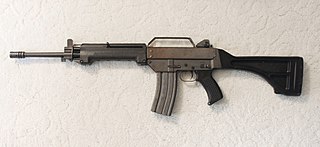
The Leader T2 MK5 Series firearms were chambered for the 5.56×45mm NATO cartridge and manufactured by Leader Dynamics of Smithfield, NSW, Australia (1978-1982/1983). The Leader was the brainchild of British weapons designer Charles St. George. It was originally a contender for a 5.56 mm Australian military service rifle to replace the then-issued Lithgow L1A1 SLR and Colt M16A1 rifles. What was unique about this endeavor was that Australia had never designed or manufactured its own commercial gas-operated semi-automatic rifle. The rifle was abandoned when the Steyr AUG was adopted for use by the Australian military.
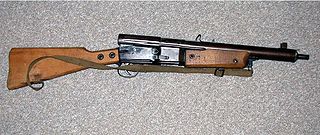
The Volkssturmgewehr is the name of several rifle designs developed by Nazi Germany during the last months of World War II. They share the common characteristic of being greatly simplified as an attempt to cope with severe lack of resources and industrial capacity in Germany during the final period of the war. The Volkspistole was a partner program, almost identical, but for pistols instead.
The following are terms related to firearms and ammunition topics.
The Saiga semi-automatic rifles are a family of Russian semi-automatic rifles manufactured by Kalashnikov Concern, which also manufactures the original AK-47 and its variants, Saiga-12 shotguns and Dragunov sniper rifle. Saiga rifles are a sport version of the Kalashnikov rifle, and are marketed for hunting and civilian use. They are sometimes referred to as Saiga Sporters.
Recoil operation is an operating mechanism used to implement locked-breech autoloading firearms. Recoil operated firearms use the energy of recoil to cycle the action, as opposed to gas operation or blowback operation using the pressure of the propellant gas.

An AR-15–style rifle is a lightweight semi-automatic rifle based on or similar to the Colt AR-15 design. The Colt model removed the selective fire feature of its predecessor, the original ArmaLite AR-15, itself a scaled-down derivative of the AR-10 design by Eugene Stoner. It is closely related to the military M16 rifle.

The Vepr-12 is a multipurpose semi-automatic detachable-magazine shotgun, produced by Molot-Oruzhie Ltd. It is patterned after the original Kalashnikov rifle and built on the heavier RPK light machine gun receiver.
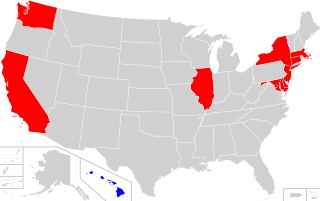
Assault weapons legislation in the United States refers to bills and laws that define and restrict or make illegal the manufacture, transfer, and possession of assault weapons. How these firearms are defined and regulated varies from jurisdiction to jurisdiction; generally, this constitutes a list of specific firearms and combinations of features on semiautomatic firearms.
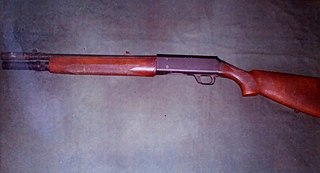
The Heckler & Koch HK 512 is a semi-automatic shotgun of Italian origin. It was developed and produced by Franchi at the request of Heckler & Koch, which took care of marketing and sales.
The Beretta 1301 is a gas-operated semi-automatic shotgun produced by Beretta and imported by Beretta USA in the United States. The firearm has two separate designs. One is intended for tactical self-defense and law enforcement applications whereas the other is designed for target shooting sports. Despite its intended applications, it is often used by a minority of hunters and sporting clay shooters.






